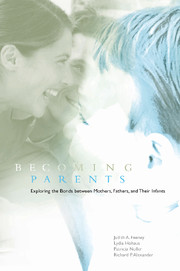Book contents
- Frontmatter
- Contents
- Preface
- 1 The Transition to Parenthood
- 2 Attachment in Childhood and Beyond
- 3 The Study
- 4 The Couples
- 5 Pregnancy and Plans for Birth
- 6 Couples' Experiences of Birth and New Parenthood
- 7 How Does New Parenthood Affect Couples?
- 8 Dealing with Depression
- 9 Men, Women, and Household Work: The Diaries
- 10 Couples' Changing Attachment Relationships
- 11 Six Months into Parenting
- 12 New Parenthood in Perspective
- Appendix A Core Questionnaires Completed by Couples
- Appendix B Summary of Sample Characteristics
- Appendix C Summary of Major Statistical Analyses
- References
- Author Index
- Subject Index
11 - Six Months into Parenting
Published online by Cambridge University Press: 05 June 2012
- Frontmatter
- Contents
- Preface
- 1 The Transition to Parenthood
- 2 Attachment in Childhood and Beyond
- 3 The Study
- 4 The Couples
- 5 Pregnancy and Plans for Birth
- 6 Couples' Experiences of Birth and New Parenthood
- 7 How Does New Parenthood Affect Couples?
- 8 Dealing with Depression
- 9 Men, Women, and Household Work: The Diaries
- 10 Couples' Changing Attachment Relationships
- 11 Six Months into Parenting
- 12 New Parenthood in Perspective
- Appendix A Core Questionnaires Completed by Couples
- Appendix B Summary of Sample Characteristics
- Appendix C Summary of Major Statistical Analyses
- References
- Author Index
- Subject Index
Summary
“Life has certainly changed! Nine pounds of absolute power, that's what a baby is. And so much control over two grown people. If she screams, we run!”
The measures we obtained soon after the birth showed the enormous range of responses to new parenthood (see Chapters 6 and 7). Some parents were finding their infants relatively easy to manage, and reported increased feelings of closeness and partnership with their spouses. Others reported a range of concerns, including difficulty in soothing the baby or “connecting” to it, loss of intimacy with the spouse, and a sense of restriction of general lifestyle. We were interested in whether this wide range of responses would still be evident four to five months later, when the parents had had more time to become attached to their babies and to develop routines for doing the chores and caring for the infant. At the final assessment, both transition and comparison couples again completed measures that evaluated their relationships and their psychological adjustment. In this chapter, we explore changes across the entire course of the study for each group. In addition, for the transition group, we look at the extent to which different couples struggled with new parenthood, and explore factors related to the ease of their transition.
PATTERNS OF CHANGE OVER TIME
As we noted in Chapter 7, our focus in this study was on tracking changes in spouses' psychological adjustment and marital relationships.
- Type
- Chapter
- Information
- Becoming ParentsExploring the Bonds between Mothers, Fathers, and their Infants, pp. 180 - 201Publisher: Cambridge University PressPrint publication year: 2001

